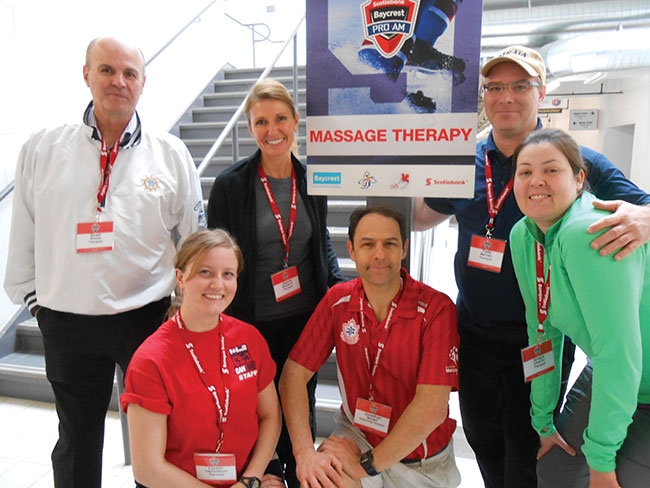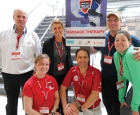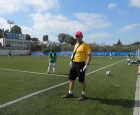
Features
Continuing Education
Education
“Double designators:” The massage and athletic therapist
What was once a timid trickle has in recent years become a steady flow. The numbers of those choosing to wear two hats – that of athletic therapy (AT) and massage therapy (MT) – has increased tremendously.
August 1, 2019 By Jonathan Maister
 From a sport standpoint
From a sport standpoint Having been an athletic therapist, I recognized early on as a student that the hands of a massage therapist were an invaluable asset. Working at the World Indoor Track and Field Championships (Toronto, 1993) I was privy to the impressive hands-on work of Ed Ratz, Grace Chan and John D’Aguanno (among others). I was sold. For me, this combination of skills was without a doubt a path to completion as a therapist.
This combination back in the 90s was rare, and I was the fifth person in Canada to merge both designations. As with the majority of like-minded therapists, studying MT came after athletic therapy. Athletic therapy in Canada evolved in the mid-1960s. The profession emerged with the need for a health care professional focused on sport medicine. Save a handful of double designators, it remained an entity inhabited on its own until recent years. Apart from those few singletons (some of whom have since retired), the natural synergy with the professions had remained unrecognized. Athletic therapists maintained solely athletic therapists – but not indefinitely.
For me it was the astounding hands of the RMT that piqued my interest. The paucity of work opportunities in the mid 90s for ATs also gave incentive to add a further designation.
For those that followed, I suspect it was the billing advantages of massage therapy that drew them to double designation. With the current transition of athletic therapy to a regulated health care profession, it may stem the flow for that reason. Other disincentives for adding a further calling are the very real opportunity costs of additional years of study which delay a full income, plus the possibility of taking on more debt.
The educational journeys of massage and AT have much in common, but they also have their respective differences and strengths. For both professions, their respective education in Canada prepares them well for the journey. With the myriad of professional development courses and the ultimate need to assist patients, the eventual destination of the therapist may be very similar.
Regardless, at that first opportunity to work with RMTs I recall witnessing the total comfort my RMT colleagues had with touching the tissue and the remarkable changes they elicited. My education so far in athletic therapy had been extensive with detailed exploration of biomechanics, mechanisms of injury, and other sport medicine related topics. Palpation had been stressed in my athletic therapy education as a diagnostic tool, but far too little as an intervention strategy. But somehow, seeing the fluid contact, the instinctive ease of engaging the tissue in such a natural way by the RMTs, was an indication to me that including this skill type would be extremely beneficial in my journey as a therapist.
Being immersed in health care for over 20 years, I have noted that patients have impressed on me the appreciation they have for manual therapy over electrical modalities. All to often the purchase of an expensive “plug in” modality has resulted in the “if you have acquired a new hammer, everything becomes a nail” phenomenon. Patients have vocalized their limited satisfaction with electrical modalities, and the sense that a more genuine care strategy with real results is associated with a hands-on approach. For this very reason I have had patients actively seek me out as a therapist.
In truth, regular close contact with the tissue of the patient, which is the raison d’etre of the RMT, provides the clinician’s ultimate tool for determining the status of the tissue – it’s heat, tonicity, fascial restriction an other subtle nuances are vital to judge the state of the patient on intake, and importantly, how the tissue is responding to treatment. After an hour’s treatment, whether it be lymph drainage, fascial release or common garden variety massage, I always ask the patient to reflect on their status. But ultimately, it’s my post-treatment palpation that completes the picture. Unfortunately a common criticism of the traditional medical system is the defecit of touch. The advent of high tech diagnostic tools have, in many ways, physically distanced the MD from the patient. These inventions have a valuable place, but a common lament among patients is that certain MDs tend to avoid a physical examination of their patient. A retired MD patient of mine, (who has since passed away) openly stated that hands-on diagnostic tools and his knowledge, were all he could rely on in his early days of practice. Hence the combination of my RMT and athletic therapy foundation makes for a refreshing U-turn in this unfortunate trend.
Typical of the myriad of professional development courses is the emphasis on manual advanced techniques. Professional development courses are made available to all interested health care professionals, but they are at a distinct advantage with the solid foundation of touch provided by the massage therapy profession.
The strong foundation with touch in the profession is definitely an asset. It can also be a strong incentive for those already qualified in parallel professions, to seek an RMT education simply because of the thorough foundation it provides with touch.
From a sport standpoint, the active component of massage is much sought after and appreciated by athletes. The evolution of sport massage as a stand-alone specialty of massage has put Canada in the forefront of this aspect of sport medicine.
In my own capacity as a provider of professional development courses, this combination is clearly reflected in the content. The detailing of applied anatomy and how this reflects on mechanisms of injury, ties in neatly with the numerous manual intervention strategies. This parallels the depth of discussion in the AT world of biomechanics and sport injuries, and the enviable comfort of massage therapy with manipulating tissue.
The combination of these professions lies not just with the physical aspect. Dealing with athletes and sedentary individuals requires a comprehensive appreciation of the human condition as a comprehensive multifaceted entity. One of my early challenges as a student was appreciating that a sprained ankle or headache was attached to a person with hopes, dreams, fears and innumerable other characteristics and frailties. While this was something I did incorporate and grow with as an Athletic Therapy student, the detailed discussions and exploration evolved tremendously with my MT training.
From a professional marketing standpoint, my sense is having both an RMT and AT designation is a great plus. As a professional, you can work in either domain as a stand-alone entity, or in the useful grey area of both in combination. For example, when seeking employment, you are able to cast a wider net. The knowledge base and skill set sourced from either profession provide a useful synergy in the job market. Either in private practice or as an employee, this resonates with potential employers or clients.
The combination of professions has been extremely beneficial. I am equally at home in both milieu having worn either hat depending on the situation, but invariably “sported both hats” simultaneously. Both have provided invaluable education opportunities, through both I have met tremendous like-minded people and made wonderful memories with many more to come.
Jonathan Maister is a certified athletic therapist, RMT and sport massage therapist based in Markham, Ont. He has presented across Canada at numerous conferences and is a regular contributor to newsletters and publications for the athletic therapy and massage therapy professions.
Print this page

